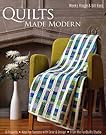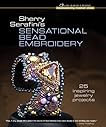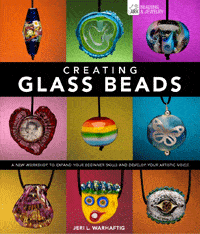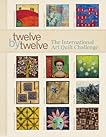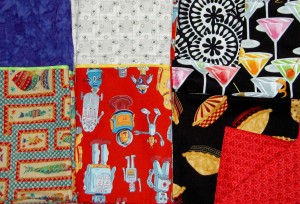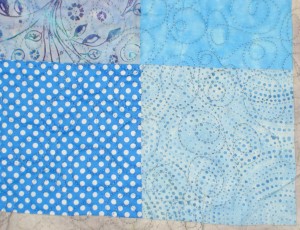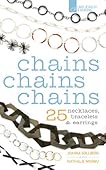 Chains Chains Chains: 25 Necklaces, Bracelets & Earrings by Joanna Gollberg
Chains Chains Chains: 25 Necklaces, Bracelets & Earrings by Joanna Gollberg
This book was sent to me for free by Sterling Publishing. Thanks to Ray at Lark and his whole team for thinking of me. I am not a jewelry maker, so this will be a basic review.
The first thing I noticed about this book is the binding. I don’t know what it is called, but the books lays flat even though it does not have a spiral. Interesting. There is a comprehensive table of contents and an index (YAY!). The authors, Joanna Gollberg and Nathalie Mornu exploit the chain part of necklaces throughout the book, starting with “A Chain Letter”, which is the introduction or foreword.
After a page of tools, the book starts into projects. The photos are large and appealing. The page layouts are light and airy and I like the circle motif the publisher used throughout the book. The projects come from different designers, but the projects have a modern feel with a lot of space between the elements. The projects do become denser as the maker works his/her way through the book. The projects look cohesive.
There is a basics section at the end, which talks about metals and their properties, including precious metals, and tools and equipment. The techniques section, which follows includes cleaning metal, transferring designs, chasing, bending sheet metal and much more. There are also sections on soldering and finishing, which I am guessing are the quilting and binding of the jewelry world. A very useful Mandrel and Ring Size conversion chart is also included.
I enjoyed looking at the inspiration section, which includes a gallery of additional pieces (not projects). I really like the Double Circle Bracelet on page 134.
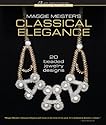 Maggie Meister’s Classical Elegance: 20 Beaded Jewelry Designs by Maggie Meister
Maggie Meister’s Classical Elegance: 20 Beaded Jewelry Designs by Maggie Meister
Maggie Meister’s Classical Elegance: 20 Beaded Jewelry was also sent to me from Lark Crafts/Sterling Publishing for free. Again, there is a comprehensive table of contents and an index as well as a very small bibliography. The gallery at the end shows several pages of amazing necklaces, which look more like museum pieces than jewelry. When I looked at some of them, I thought they might be historical reproductions, but I don’t see anything that says one way or another.
The first part of the book goes over basic tools and stitches. The author talks a bit about the pros and cons of different clasps, the Great Thread Wars, and different types of ear wires and posts. I like it that she injects a bit of humor into what can be a boring, rote section. Stitches, both in the beginning and in the projects include a lot of diagrams so the maker can clearly see the author’s method of creating. The stitches section would be good for quiltmakers who are embellishing their quilts.
I like it that Ms. Meister talks about her inspiration, which, in part, comes from ancient pieces. Each project has a brief description of something historical that influenced the piece. The inspiration could be common practices at the time, marriage jewelry, and torques worn in ancient Ireland. I would have liked to have seen some footnotes for these comments.
I think most of the projects in the book walk the fine line between lush and over-the-top very well.
Chapter 5, starting on page 96, is called Architectural elements as Inspiration. The facing page (pg.97) has photos of chimneys, title, a Russian (or maybe Greek?) Orthodox church and other architectural elements that can serve as inspiration for any kind of creativity.
Check this book out and see how different things in the world around you can inspire your creative work.
 21st Century Jewelry: The Best of the 500 Series by Marthe Le Van
21st Century Jewelry: The Best of the 500 Series by Marthe Le Van
For my purposes, this book is definitely the best of the three. This book is pure eye candy. Thanks to Ray at Lark for sending me this book for free!
The foreword and juror statements are a little bit strangely formatted. The designer of the book used different sizes within the same sentences, which makes parts of the text jump out at’ me when I read. I wonder if I just read the larger text if there would be some kind of subliminal message? I didn’t take the time to try that.
Starting on page 12, there is very little text – just artists’ names and the names of pieces as well as size and materials used. The major part of the book is all about inspiration. Most of these pieces are art and could not really be worn anywhere where you had to get in a car or pick up a drink much less to work or to pick up the kids at daycare. The Puddle Series Bracelet is one such piece. It doesn’t matter, though, because these one of a kind (presumably) pieces are gorgeous to look at
These pieces are also not the thrown together pieces that can be made in a few hours. The shapes and forms are, in many cases, organic and curvilinear. The colors are also, mostly, neutrals and golds. There are a few pieces with other colors and they really shine. Most of the pieces are metal, but I saw a few fiber pieces. One of my favorite pieces is I Long for Your Touch (pg. 99) by Roberta and David Williamson. I like the face and leaf shapes.
It is not clear to me what type of jewelry many of the pieces are intended to be. I am not bothered by this, because I won’t be buying or wearing these pieces and can be inspired from bracelets and broaches. If you need to rev up your creativity, take a look at this book, regardless of your medium.
Check the A Work of Heart blog for a giveaway of one of these books. A Work of Heart is San Jose is an awesome art studio where experienced artists teach a variety of jewelry classes as well as other classes. It takes me an hour to get there and it is well worth the drive. In a way it is good that the studio is not around the corner. If it was, i would not see my child grow up or remember my family and I would be broke, because I would be there all. the. time. If you haven’t been there, make the time. Not only will you have fun, you will be inspired.
